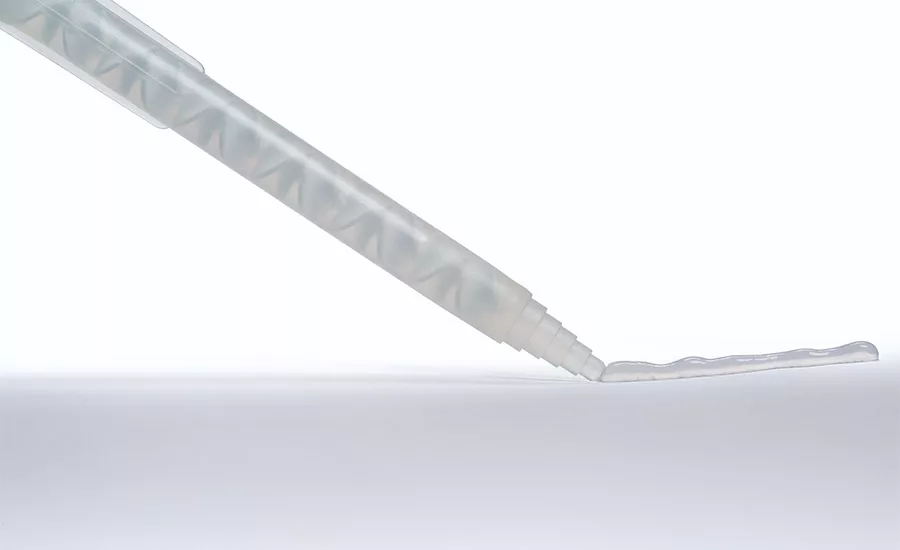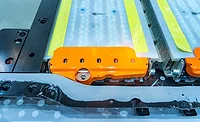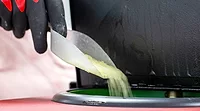Faster Cures, Stronger Bonds: The Role of Next-Gen Silicone Adhesives in Medical Manufacturing

courtesy of NuSil

courtesy of NuSil
From short-term wearable applications to long-term implantable devices, the right silicone adhesive can significantly impact product longevity, patient safety, and overall device performance. To ensure the device performs under expected and unexpected conditions, medical device manufacturers have unique requirements and are increasingly demanding customized silicone formulations to meet them.
The harsh demands of healthcare place a unique set of constraints on the technologies that take us there, so device manufacturers must leverage the latest developments in silicone chemistry.
Rapid cures and lasting strength — these are the usual aspects considered. However, selecting the ideal adhesive requires a careful evaluation of multiple factors, from cure speed and resistance to environmental stressors to material compatibility, flexibility, and biocompatibility. During the feasibility and R&D phases of medical device development, selecting the right silicone elastomer is an important component of ensuring performance, scalability, and compliance.
Regardless of application, choosing the right adhesive involves evaluating several factors.
Material and Process Selection
Silicone elastomers are generally categorized into three different types: high-consistency rubbers (HCRs), liquid silicone rubbers (LSRs), and low-viscosity elastomers (LVEs). Implantable-grade elastomers are available with enhanced purity and conformance with ISO 10993 and USP Class VI standards, making them ideal for long-term medical implants.
Factors such as mechanical properties, processing methods, and regulatory requirements influence material selection. High-consistency rubbers (HCRs) are ideal for applications requiring high tear strength and elongation and are best suited for extrusion or compression molding. Liquid silicone rubbers (LSRs) excel in high-volume production due to their precision in injection molding. Low-viscosity elastomers (LVEs), while not easily scalable, are useful for potting and filling applications in prototyping and specialized medical components.
Liquid Silicone Rubber (LSR)
Unlike high-consistency rubber (HCR), LSRs have a more liquid-like viscosity similar to petroleum jelly. This makes them ideal for injection molding and the production of intricate, high-precision components such as seals, gaskets, and catheters.
Among their key advantages are thermal stability and resistance to chemicals, UV exposure and variable conditions. LSRs can perform effectively in a range of temperatures from -60 °C to +250 °C, which is mandatory for certain sterilization and long-term implantation applications. Recent advancements in faster-curing formulations have significantly improved production efficiency, reducing cycle times and enabling high-volume manufacturing. The combination of precision molding, rapid processing, and excellent mechanical properties — including optical clarity for applications like LED encapsulation — has cemented LSR’s role as a preferred material in next-generation medical devices.
Low-Viscosity Elastomers (LVE)
Low-viscosity elastomers are designed to have unique rheological properties that lend themselves to applications involving potting and encapsulating. These materials flow or self-level and are not designed to be thixotropic. Because of this, mixing and de-airing these materials can be somewhat easier than mixing and de-airing an LSR. However, the physical properties may be compromised.
LVEs typically have lower tear resistance and elongation when compared to LSRs and HCRs. Manufacturers should consider the scale-up of their device, as lower viscosity materials such as LVEs may not be compatible with traditional injection molding processes.
Compared to LSRs or HCRs, LVEs are also available in a wider range of refractive indices, which makes them best suited for applications requiring optical clarity and precision.
From Substrate to Sterilization: Selecting Adhesives for Specific End Uses
For medical device assembly, determining the end-use application early in the design process can help in selecting the appropriate grade of silicone adhesives — and some key aspects must be considered. The key aspects to consider center around the type of the device: If it will be short term (≤29 days) or long term (>29 days) implantable, or if it requires permanent adhesion (e.g., catheters, pacemakers, and cochlear implants), or whether it will be a wearable device that demands temporary adhesion.
Going further to ensure success, one of the first steps is to verify that the substrate is compatible with the chosen adhesive. Whether a device is constructed from a single material or a mix of plastics, metals, or silicones, manufacturers should be familiar with the necessary preparation techniques — such as substrate cleaning, plasma or corona treatments, and the use of silicone primers — to boost surface energy and ensure a proper bond.
It is also crucial to consider how different sterilization methods affect the adhesive over time. For example, radiation sterilization — such as gamma or e-beam — can lead to extra crosslinking that alters the adhesive's mechanical properties and might impact the device's performance.
By understanding an adhesive's viscosity (or flow characteristics), based on the assembly requirements, manufacturers can choose either a self-leveling, low-viscosity adhesive or one with thixotropic properties.
Both one-part and two-part curing systems offer significant advantages in medical device assembly, including proven biocompatibility and flexibility. Once fully cured, they form soft, elastomeric bonds with high elongation and durability, which allows them to withstand mechanical stresses and thermal expansion without cracking or losing adhesion. Their ability to form strong yet flexible seals make them particularly useful for catheter bonding, device sealing, and other applications where a secure yet adaptable bond is needed.
One-part Condensation-cure Silicone Adhesives
Traditional one-part condensation-cure silicone adhesives are tin-catalyzed and cure by exposure to atmospheric moisture. Because they are supplied as a single-component formulation, the need for precise mixing is eliminated, reducing handling errors and simplifying application. They can be used in applications requiring either thixotropic or self-leveling properties, such as adhering a silicone balloon to the distal end of a urinary catheter. Because they do not need heat for curing, they are compatible with temperature-sensitive devices. Compared to two-part addition-cure adhesives, they have shorter work times and longer cure times and can be limited by thickness and exposed surface area for effective curing. During this process, they can also release reaction byproducts — such as acids or alcohols — that can cause shrinkage and require proper ventilation or exhaust systems. A post cure or additional cleaning step may be used to remove byproducts from the system.
While they cure more slowly than two-part systems, one-part condensation-cure silicone adhesives' ease of handling and reliable performance make them a good choice for applications where manufacturing complexity needs to be minimized, and a gradual cure time is acceptable.
Two-part Addition-cure Silicone Adhesives
For accelerated curing using heat, the preferred choice is usually two-part addition-cure silicone adhesives, which are platinum catalyzed. These systems require mixing a part A and part B together to initiate the crosslinking reaction. Addition curing adhesives are available in RTV (room-temperature vulcanizing) and HTV (high-temperature vulcanizing) formulations. They adhere to a wide range of substrates for applications such as bonding dissimilar materials, encapsulating, or sealing. Unlike condensation-cure systems, addition-cure adhesives do not release byproducts during vulcanization, eliminating the need for postcure and reducing shrinkage. Additionally, two-part systems are not limited to depth of cure, so thicker parts with less exposed surface area may benefit from this curing system.
As a drawback, manufacturers need to consider their susceptibility to so-called cure "poisons," where the catalyst can be easily inhibited or poisoned by incompatible compounds. Substances that contain sulfur (such as natural rubber, latex, or polychloroprene), nitrogen (like amines), or organotin (found in condensation-cure silicones), as well as certain pharmaceutical drugs and conductive fillers, can interfere with platinum-catalyzed silicone systems. Ensuring the handling of platinum-curing silicones (with separate tools, areas, and ovens, etc.) away from any potential poisons or inhibitors, is an important step in setting up the manufacturing process. Specialized primers can be used to help combat potential issues with inhibition. Inhibitors can also be used in a controlled manner to formulate platinum curing systems to have finely tuned work times, extending the time the material can be processed once catalyzed.
Solvent-dispersed Silicone Adhesives and Films
To bond, encapsulate, or coat device components, manufacturers can use solvent-dispersed adhesives. Both one-part condensation-cure and two-part addition-cure silicone adhesives can retain their properties when dispersed, enabling thin-film application by spraying, dipping, or brushing.
Soft Skin Adhesives
Manufacturers may consider soft skin adhesives for wearable devices or wound healing applications. These silicone adhesives are formulated as gels, which are soft, compliant, and tacky. This will help them adhere mechanically to the skin. Because these materials are not elastomers, they will not have the same mechanical strength as HCRs, LSRs, and LVEs. These materials are well suited for transdermal drug delivery applications.
Silicone Primers
Silicone primers can help promote adhesion between two substrates. They are usually used in addition to a silicone adhesive. A primer is applied to the substrate before the adhesive is applied. These materials contain reactive silanes dispersed in a solvent, which are designed to bond to various substrates and help secure the bond of the silicone adhesive.
Similar to one-part adhesives, these primers are reactive with ambient moisture, meaning that special care should be taken when using them to ensure proper bonding is achieved. Since they react with moisture, primers should be stored in tightly sealed containers and used promptly to prevent premature degradation. After application, primers require a brief drying time, starting from around 30 minutes, depending on environmental conditions, to allow the solvent to evaporate and the reactive silanes to activate. The primer will then form a thin, reactive layer that chemically links with both the substrate and the silicone adhesive, improving adhesion strength and long-term bond reliability.
Silicone Expertise and Support
Silicone materials and technologies are embedded and integral to the performance of life-changing products. As each device comes with a myriad of considerations, it is essential to choose an experienced silicone supplier who works side by side with customers at every step of their journey, from research to commercialization. The supplier should have ISO 9001 certification, deep knowledge of ISO 13485 quality management requirements for medical systems, and experience with the U.S. Food and Drug Administration (FDA) Master File and Drug Master File submissions (MAFs and DMFs).
Learn more about NuSil at https://nusil.avantorsciences.com/nusil.
Article images courtesy of NuSil.
Looking for a reprint of this article?
From high-res PDFs to custom plaques, order your copy today!





